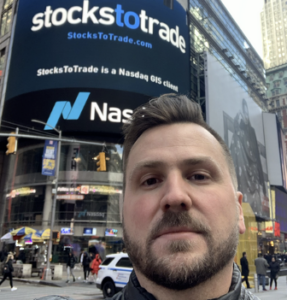
Fintech Marketing 101: An Interview with Zak Westphal on Connecting with Retail Investors
The world of finance is going through a major shakeup thanks to new technologies transforming how everyday investors manage their money. This emerging world of “fintech”—a blend of financial services and cutting-edge tech—is rewriting the investing rulebook.
It’s both an exciting and complex landscape. Established players are scrambling to adapt as agile startups nip at their heels with game-changing ideas. So how can these smaller fintechs cut through the noise to connect with retail investors?

Zak Westphal
To dig into this question, we sat down for a chat with Zak Westphal, a fintech trailblazer who knows firsthand what it takes. Zak founded StocksToTrade, an algorithmic trading platform empowering ordinary investors with tools once exclusive to big institutions.
By taking a community-first approach, Zak has organically grown StocksToTrade’s user base to over 30,000 engaged retail traders and investors. In the conversation, he shared insider tips for fintech entrepreneurs looking to follow in his footsteps and forge meaningful relationships with the retail investor audience.
Q1: Zak, what do you see as the biggest challenge in marketing fintech products to retail investors?
I’d say the biggest hurdle is rising above the constant flood of noise vying for their attention. Retail investors get nonstop pitches from what feels like endless sources. So it’s tough to grab their focus when you’re peddling intricate, multi-layered fintech.
You’ve got to boil down your message to the bare basics and spell out exactly how your product can help people accomplish their money goals compared to other options out there. Don’t get bogged down in complex details. Keep it simple and crystal clear how your solution makes their financial lives easier or more effective. That’s what it takes to stand out from the constant barrage of financial marketing.
Q2: How does StocksToTrade approach this challenge?
Through trial and error, we’ve learned first-hand that education is the key that unlocks the door. A whole lot of everyday investors are hungry for knowledge but just don’t have helpful resources that meet them where they are. So our game plan is to give them two critical pieces of value: quality teachings plus our innovative tools.
When we take tangled trading strategies and break them into easy-to-digest modules—and then show real examples of our community using the software—we empower people to make smarter trading decisions. This one-two punch attracts newbies curious to learn the game while also building hardcore loyalists within our existing member base. Those who soak up our lessons and turn them into wins stick with us for the long haul.
Q3: What role does community play in your marketing strategy?
Community is absolutely essential. Investing can feel like a solo trek into the wilderness if you don’t have solid support, especially when you’re new. That’s why we’ve focused hard on building up a tight-knit crew around our platform. It lets traders lean on each other, swap ideas, and celebrate wins.
We keep the camaraderie flowing across social channels, webinars, and live gatherings. This constant interaction is a two-way street – we get to hear user feedback firsthand, tackle issues, and level up our offerings. And it gives members a true sense of belonging beyond just using the same software. In essence, our community fuels our product rather than the other way around. It’s a secret sauce we’ll always keep building on.
Q4: How do you differentiate your messaging in a crowded fintech market?
Authenticity sets us apart. In a sector often steeped in hype and technical lingo, we focus on being transparent and genuine. We don’t pitch unrealistic promises or claim we’ve discovered some foolproof method to shortcut success. Instead, we emphasize the value of rolling up your sleeves – embracing the hard graft, sweat, and ongoing education intrinsic to thriving in this business.
We spotlight real traders sharing vulnerable stories – their breakthroughs and setbacks alike. This candid peek behind the curtain distinguishes us from surface-level spin. By keeping it real about the journey, we build meaningful connections rooted in trust. I believe that traders sense our authenticity – that we live and breathe the grind just like them.
Q5: What advice would you give to fintech startups looking to reach retail investors?
I’d urge them to zero in on fixing actual real-world issues. It’s tempting to get sucked into flashy trends or attempt to be everything for everybody – but that’s quicksand. Instead, drill down to a concrete frustration retail traders face and craft a solution tailored exactly for that gap. Make user experience central too – if your product isn’t intuitive or smooth for newcomers, it’s game over fast.
And never dismiss the power of tapping hearts overheads. Share the human stories woven into your brand and the tangible impact you have on the lives of real people. That emotional connection can fuel explosive growth.
All in all, keep it simple, address pain points, and smooth the journey – do those things exceptionally well before moving to the next shiny object. Solve problems and tell stories.
Q6: Looking ahead, how do you see fintech marketing evolving in the coming years?
I believe we’ll see a continued shift towards personalization and data-driven strategies. With AI and complex algorithms working behind the scenes, financial brands can hyper-target content and suggestions to resonate with each specific investor.
Mobility won’t lose steam either—managing money on the fly via smartphones is now baked into everyday habits. Catering to that mobile-first reality will be mandatory. I also envision video and live chat playing a bigger role since people still value human interaction and bite-sized knowledge nuggets.
As for the old-guard (long standing financial institutions), they’ll tap into fintech’s magic more than ever through slick collaborations. The lines between the two camps will get even more blurred.
Honestly, with nonstop innovation brewing, it’s a thrill to have a front-row seat as financial marketing reinvents itself. The next era promises to be a game-changer.




















